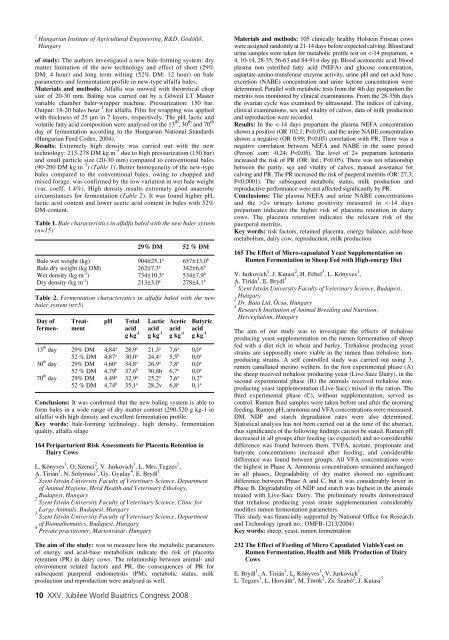Oral and Poster Abstracts
Oral and Poster Abstracts
Oral and Poster Abstracts
You also want an ePaper? Increase the reach of your titles
YUMPU automatically turns print PDFs into web optimized ePapers that Google loves.
2<br />
Hungarian Institute of Agricultural Engineering, R&D, Gödöllô,<br />
Hungary<br />
of study: The authors investigated a new bale-forming system: dry<br />
matter limitation of the new technology <strong>and</strong> effect of short (29%<br />
DM: 4 hour) <strong>and</strong> long term wilting (52% DM: 12 hour) on bale<br />
parameters <strong>and</strong> fermentation profile in new-type alfalfa bales.<br />
Materials <strong>and</strong> methods: Alfalfa was mowed with theoretical chop<br />
size of 20-30 mm. Baling was carried out by a Göweil LT Master<br />
variable chamber baler-wrapper machine. Pressurization: 150 bar.<br />
Output: 18-20 bales hour -1 for alfalfa. Film for wrapping was applied<br />
with thickness of 25 µm in 7 layers, respectively. The pH, lactic <strong>and</strong><br />
volatile fatty acid composition were analysed on the 13 th , 30 th <strong>and</strong> 70 th<br />
day of fermentation according to the Hungarian National St<strong>and</strong>ards<br />
(Hungarian Feed Codex, 2004).<br />
Results: Extremely high density was carried out with the new<br />
technology: 213-278 DM kg m -3 due to high pressurization (150 bar)<br />
<strong>and</strong> small particle size (20-30 mm) compared to conventional bales<br />
(90-200 DM kg m -3 ) (Table 1). Better homogeneity of the new-type<br />
bales compared to the conventional bales, owing to chopped <strong>and</strong><br />
mixed forage, was confirmed by the low variation in wet bale weight<br />
(var. coeff. 1.4%). High density results extremely good anaerobe<br />
circumstances for fermentation (Table 2). It was found higher pH,<br />
lactic acid content <strong>and</strong> lower acetic acid content in bales with 52%<br />
DM-content.<br />
Table 1. Bale characteristics in alfalfa baled with the new baler system<br />
(n=15)<br />
29% DM 52 % DM<br />
Bale wet weight (kg) 904±25,1 a 657±13,0 b<br />
Bale dry weight (kg DM) 262±7,3 a 342±6,6 b<br />
Wet density (kg m -3 ) 734±10,3 a 534±7,9 b<br />
Dry density (kg m -3 ) 213±3,0 a 278±4,1 b<br />
Table 2. Fermentation characteristics in alfalfa baled with the new<br />
baler system (n=5)<br />
Day of Treat- pH Total Lactic Acetic Butyric<br />
fermen- ment acid<br />
g kg<br />
acid acid acid<br />
-1<br />
g kg -1<br />
g kg -1<br />
g kg -1<br />
13 th day 29% DM 4,84 a 28,9 a 21,3 a 7,6 a 0,0 a<br />
52 % DM 4,87 a 30,0 a 24,4 a 5,5 b 0,0 a<br />
30 th day 29% DM 4,60 a 34,8 a 26,9 a 7,8 a 0,0 a<br />
52 % DM 4,79 b 37,6 b 30,8b 6,7 a 0,0 a<br />
70 th day 29% DM 4,49 a 32,9 a 25,2 a 7,6 a 0,2 b<br />
52 % DM 4,74 b 35,1 a 28,2v 6,8 a 0,1 a<br />
Conclusions: It was confirmed that the new baling system is able to<br />
form bales in a wide range of dry matter content (290-520 g kg-1 in<br />
alfalfa) with high density <strong>and</strong> excellent fermentation profile.<br />
Key words: bale-forming technology, high density, fermentation<br />
quality, alfalfa silage<br />
164 Periparturient Risk Assessments for Placenta Retention in<br />
Dairy Cows<br />
L. Könyves 1 , O. Szenci 2 , V. Jurkovich 1 , L. Mrs. Tegzes 1 ,<br />
A. Tirián 1 , N. Solymosi 3 , Gy. Gyulay 4 , E. Brydl 1<br />
1 Szent István University Faculty of Veterinary Science, Department<br />
of Animal Hygiene, Herd Health <strong>and</strong> Veterinary Ethology,<br />
Budapest, Hungary<br />
2 Szent István University Faculty of Veterinary Science, Clinic for<br />
Large Animals, Budapest, Hungary<br />
3 Szent István University Faculty of Veterinary Science, Department<br />
of Biomathematics, Budapest, Hungary<br />
4 Private practitioner, Martonvásár, Hungary<br />
The aim of the study: was to measure how the metabolic parameters<br />
of energy <strong>and</strong> acid-base metabolism indicate the risk of placenta<br />
retention (PR) in dairy cows. The relationship between animal- <strong>and</strong><br />
environment related factors <strong>and</strong> PR, the consequences of PR for<br />
subsequent puerperal endometritis (PM), metabolic status, milk<br />
production <strong>and</strong> reproduction were analysed as well.<br />
10 XXV. Jubilee World Buiatrics Congress 2008<br />
Materials <strong>and</strong> methods: 105 clinically healthy Holstein Frisean cows<br />
were assigned r<strong>and</strong>omly at 21-14 days before expected calving. Blood <strong>and</strong><br />
urine samples were taken for metabolic profile test on

















